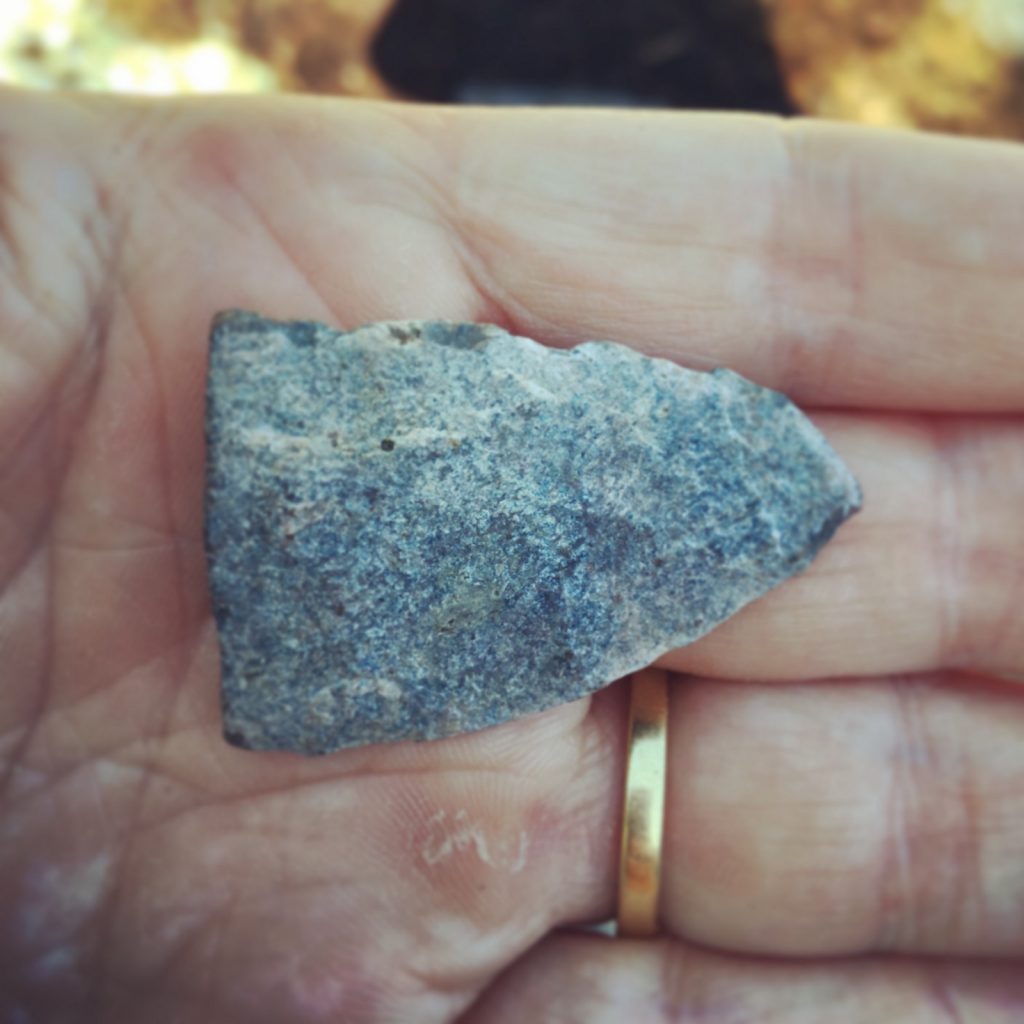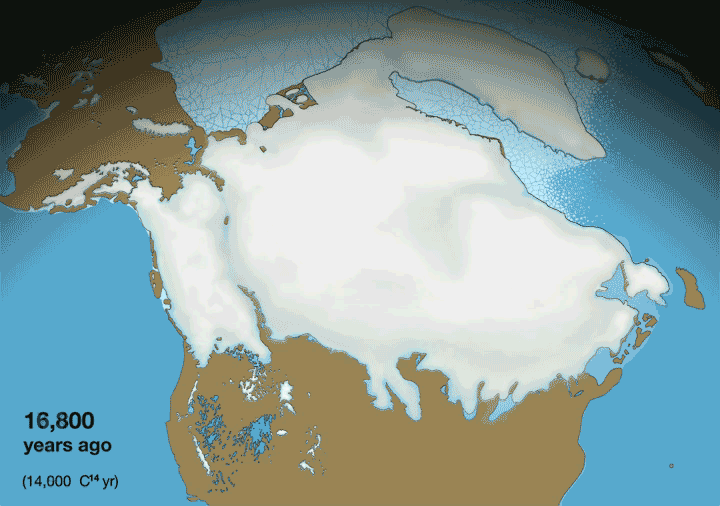
I reached down, and picked up the stone.
It didn’t look like the other rocks on the beach. It was triangular, with gently curved sides tapered to a point, the surface and edges marked with dips and curves, as though someone had scooped the surface with a tiny spoon. And the cross section appeared oval-shaped and nearly symmetrical, each end tapered to a gentle point.

Here was clearly something shaped by human hands and very old, buffed by untold seasons in the wind, waves and sun, worn and smooth to the touch.
I wasn’t certain it was an arrowhead, but my imagination immediately ran wild. “Who made this thing? What is it exactly? How old is it?”
Back at the house in the tiny fishing village off the coast of Maine, I asked our host Phil if he had an opinion on the find.
“That’s an arrowhead all right,” he said. “Probably made by the Red Paint People.”
The Red Paint People?
“We don’t know a lot about them. But they were here a long time ago, and they made things like that.”
I was intrigued.
Back home in New York the following week, I sent photos of the object to several professors, curators and archaeological societies around the Northeast in hopes that someone could help me identify it. A geologist at Williams College held the opinion that the stone was rhyolite, a material commonly used by paleo-Indians for stone tools and weapons. There was a source of rhyolite not far from the beach where I found the stone, and he surmised it could have come from there — but as archaeology was not his field, he couldn’t identify the object any further.
I heard from Dr. Arthur Spiess of the Maine Archaeological Society, and Julia Gray of the Abbe Museum in Bar Harbor, Maine, who both agreed that the artifact was not an arrowhead, but actually the distal (pointy) end of a stone knife, blade or spear point that had broken from the haft, likely while it was still in the possession of its creator. They placed the date of its creation at some point between 500 years ago (pre-European), or as far back as 6000 years, near the time the last ice age came to an end.
Wow.
This got me to thinking about the ancient people of North America—what archaeologists now call paleo-Indians — the native people who lived on this continent in the millennia following the end of the last ice age. We’re talking 11,000 to 1000 BCE. The ancient people of that time lived through something that hasn’t happened in almost as many years, but is beginning to happen again now: climate change on a global scale.
Archaeologists believe that the Red Paint People, so named for the red ochre or iron oxide powder found encircling their burial sites, may have lived in coastal settlements near the mouths of rivers, all the way out to the edge of the continental shelf on land that is now submerged beneath hundreds of feet of ocean.
It’s believed that sea levels were more than 300 feet lower then than they are today, and, precipitated by massive deglaciation (the melting of the glaciers), in a relatively short period of time

likely rose to near their current levels. But sea level rise isn’t the only reason we know so little about the Red Paint People, or that their land is under water. The geological process of Subsidence — essentially, one part of the earth’s crust being pushed down by another part of it — also occurred, forcing the land to sink beneath the water at twice the rate of global sea level rise. The result is that huge swaths of coastal ice-age North America vanished underneath the ocean in a relatively brief period of time.
How did the ancients react to massive coastal flooding on a catastrophic scale? What did they do to survive? These questions led me to even more questions, which are hard to answer given the yawning stretch of time between us and the peoples of the past. They left no writing, and the few artifacts they did leave behind provide only glimpses into their way of life and their history. Yet native peoples continued to inhabit North America, and still live here today, despite facing several periods of near extinction. How then, does a culture survive for 10,000 years or more? We don’t really know conclusively when the first peoples came to the Americas — some believe the genetic and archaeological evidence may point to multiple points of arrival, and dates stretching back as far as 30,000 years ago. If that’s the case, The American Indian has lived on this continent continuously for thousands and thousands of years, while our modern industrial society has only been around for two centuries and change. And we’re already feeling the pinch of resource depletion and environmental destruction.
Now, at a moment when Native peoples and their advocacy for the earth are again emerging into the public consciousness for the first time in decades, and perhaps at a scale that hasn’t been seen in more than a century, what lessons can we learn from the legacy of the indigenous humans who were the first pioneers in this continent? Can we look to them to learn to sidestep climate change?
Here are five takeaways on living in harmony with the earth that we can glean from a culture that has our society beat on longevity by a factor of fifty.
- Know your environment. Plants, animals, water, shelter, weather, seasons, to name a few. The paleo-indians were intimately familiar with all of the elements of their surroundings. They learned to identify the plants in their vicinity and how to use them. They learned how to live with the animals. How to survive in their habitat in a way that supported their communities, but considered the impact their decisions would have on future generations.
- Respect your resources and don’t get too greedy. The first peoples intuitively understood that their survival depended on the plants and animals of their environment, and while they lived in geographies with abundant fish and wildlife, they were cautious and conscientious in how they extracted value from those resources. They took what they needed, but remained mindful that if they wanted to enjoy those resources long into the future, they would have to be moderate in the way they used those resources today.
- Use everything, don’t waste. It’s an age-old trope that indigenous cultures used all parts of the animals that they hunted — the meat for food and skins for clothing, the bones for tools and adornments; waste was a form of sin against God. The mindset of using what you have because resources are precious is a central tenet of their beliefs.
- Don’t get too comfortable. Nomadic people moved around a lot — living off the land sometimes means that the land you’re living on is no longer livable; hence you have to move to survive. The early peoples of North America lived in such a way as to follow their sources of food, maintaining mobile shelters such as teepees and modes of transportation like canoes that enabled them to travel efficiently and cover great distances. They often made seasonal journeys following herds or animal sources of food, fishing and hunting in warmer months and moving south in the winter. Permanent settlements came later. They recognized that the land could not support them at all times, and that it had to go through periods of fallowness to replenish its abundance.
- Make decisions as a community, not individual rulers. The American Indians were often structured as communal decision making bodies, making choices in dialogue and consensus building rather than at the bidding of a central ruler. Hence, their choices tended to consider longterm consequences rather than the narrow interests of a select few.
How do we integrate these ideas into our world today? Can we shift our thinking and our actions to reintroduce these ideas into our world, and find ways to live in greater harmony with nature, and with ourselves? What will have to change?
Or is it too late, and have we come too far down the path of resource depletion and man-made climate change to reverse what we’ve done? Are we headed down the path of extinction? The stakes have never been higher for human beings, and for all life on earth. Perhaps by learning about the peoples of the past, observing how they created sustainable communities that survived for tens of thousands of years, we can take some lessons that may help us point the way to a more harmonious future.
For more information about the Red Paint People, paleo-Indians, and American Indian history in Maine:
The Swordfish Hunters, by Bruce Bourque
Twelve-Thousand Years: American Indians in Maine, by Bruce Bourque
Pre-European Indians, Maine Historical Society
Abbe Museum, Bar Harbor, Maine
